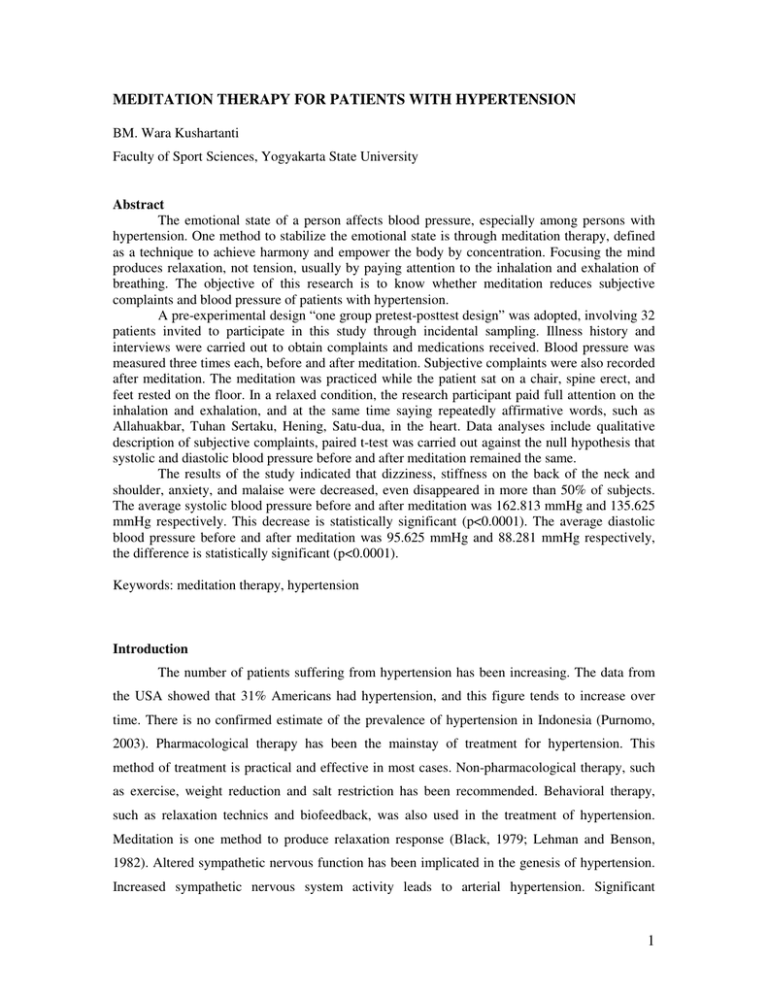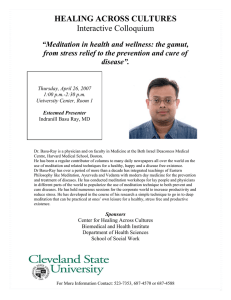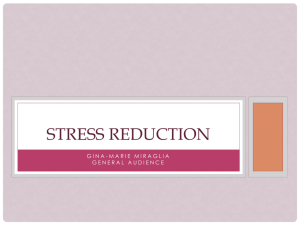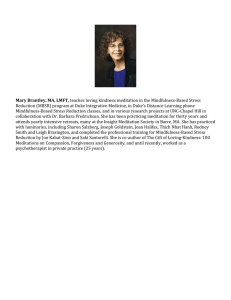MEDITATION THERAPY FOR PATIENTS WITH HYPERTENSION
advertisement

MEDITATION THERAPY FOR PATIENTS WITH HYPERTENSION BM. Wara Kushartanti Faculty of Sport Sciences, Yogyakarta State University Abstract The emotional state of a person affects blood pressure, especially among persons with hypertension. One method to stabilize the emotional state is through meditation therapy, defined as a technique to achieve harmony and empower the body by concentration. Focusing the mind produces relaxation, not tension, usually by paying attention to the inhalation and exhalation of breathing. The objective of this research is to know whether meditation reduces subjective complaints and blood pressure of patients with hypertension. A pre-experimental design “one group pretest-posttest design” was adopted, involving 32 patients invited to participate in this study through incidental sampling. Illness history and interviews were carried out to obtain complaints and medications received. Blood pressure was measured three times each, before and after meditation. Subjective complaints were also recorded after meditation. The meditation was practiced while the patient sat on a chair, spine erect, and feet rested on the floor. In a relaxed condition, the research participant paid full attention on the inhalation and exhalation, and at the same time saying repeatedly affirmative words, such as Allahuakbar, Tuhan Sertaku, Hening, Satu-dua, in the heart. Data analyses include qualitative description of subjective complaints, paired t-test was carried out against the null hypothesis that systolic and diastolic blood pressure before and after meditation remained the same. The results of the study indicated that dizziness, stiffness on the back of the neck and shoulder, anxiety, and malaise were decreased, even disappeared in more than 50% of subjects. The average systolic blood pressure before and after meditation was 162.813 mmHg and 135.625 mmHg respectively. This decrease is statistically significant (p<0.0001). The average diastolic blood pressure before and after meditation was 95.625 mmHg and 88.281 mmHg respectively, the difference is statistically significant (p<0.0001). Keywords: meditation therapy, hypertension Introduction The number of patients suffering from hypertension has been increasing. The data from the USA showed that 31% Americans had hypertension, and this figure tends to increase over time. There is no confirmed estimate of the prevalence of hypertension in Indonesia (Purnomo, 2003). Pharmacological therapy has been the mainstay of treatment for hypertension. This method of treatment is practical and effective in most cases. Non-pharmacological therapy, such as exercise, weight reduction and salt restriction has been recommended. Behavioral therapy, such as relaxation technics and biofeedback, was also used in the treatment of hypertension. Meditation is one method to produce relaxation response (Black, 1979; Lehman and Benson, 1982). Altered sympathetic nervous function has been implicated in the genesis of hypertension. Increased sympathetic nervous system activity leads to arterial hypertension. Significant 1 reduction of elevated levels of blood pressure can be achieved by meditation, breathing exercise, and progressive muscle relaxation, all of which elicit relaxation response. Stress reduction by transcendental meditation in a period of 4 months significantly reduced blood pressure among African American adolescents with high-normal systolic blood pressure (Barnes et al., 2004). A randomized controlled trial comparing transcendental meditation, progressive muscle relaxation, and participation in conventional health education classes by African Americans with hypertension showed that the greatest decrease in systolic and diastolic blood pressure was attained by those practicing meditation (Schneider et al., 2005). Ada (1999) defined meditation therapy as a technics to attain harmony and to empower the body through concentration. Meditation has been shown to affect decreased sympathetic nervous system arousal, hypothalamic-pituitary-adrenocortical axis dysregulation, cortisol levels, and sympathetic β-adrenergic receptor sensitivity (Barnes et al., 2001). Deep meditation state produces delta waves in the brain like a person who is sleeping soundly. In this state, a person feel a total relaxation with respiration over heart rate ratio 1:3. This means that one full breath takes equivalent time period as three heart beats. This practice harmonizes all organ activities, even at molecular level. The body has the ability to regulate and heal itself. Meditation enhances the harmonization and self treatment (Jaffe, 1980). Effective self-regulation and self-treatment may decrease blood pressure in patients with hypertension. Hypertension is a major cause of coronary heart disease, stroke and renal failure due to end-organ damage. Mild, medium and severe hypertension are characterized by systolic blood pressure 140-159 mmHg, 160-179 mmHg, and 180-209 mmHg respectively, and diastolic blood pressure 90-99 mmHg, 100-109 mmHg, and 110-119 mmHg respectively. If the systolic and diastolic blood pressure are 210 mmHg and 120 mmHg or more, the disease is classified as very severe hypertension. Most people suffer from hypertension with unknown etiology, categorized as essensial or primary hypertension. Only 10% of those with hypertension have other diseases which increase the blood pressure, hence the hypertension is classified to secondary. The most frequently reported symptoms are headache, pain or tension on the back of the head, neck and even the shoulders. People with hypertension often feel tired and malaise, withoud any known cause. Hypertension is not precisely a disease, but a disorder in the regulation of blood pressure. Most blood vessels have the intrinsic capacity to compensate changes by affecting the resistance to blood flow so that adequate blood supply relative to need is achieved. Metabolic changes, such as the decrease of O2 and pH produce vasodilatation, relaxation of arterioles and precapillary sphincter. The increase in CO2 and osmolality also cause dilatation of blood vessels. The dilating effect of CO2 is readily apparent on the skin and the brain. Systemic regulation may 2 also result from hormonal effects, such as kinin, which produces vasodilatation, and several hormones, such as vasopressin, norpeinephrine, epinephrine and angiotensin II, which produce vasoconstriction. Meditation practice reduces acute and chronic sympathetic nervous system tone and possibly modification of other neuroendocrine and neurophysiologic mediators of stress. The effects of the meditation practices on hypertension are restoration of adaptive mechanisms (Walton et al., 2002). The objective of this research is to know short term subjective and objective effects of meditation in persons with hypertension. Subjective effects are characterized by the decrease of symptoms, and objective effects are shown as the decrease of blood pressure. This study tested the null hypothesis that meditation does not decrease subjective symptoms and blood pressure in patients with hypertension. Methods The design of this study is pre-experimental “one group pretest-posttest design”. The usual notation for this design is: O1 X- O2 where O1 is the pretest, X is the treatment (in this case meditation), and O2 is the posttest. The subjects of this study were persons with systolic blood pressure 140 mmHg or higher, and diastolic blood pressure 90 mmHg or higher, with or without medication with antihypertensives. A total sample of 32 persons were obtained through incidental sampling. Thirteen persons were members of a sport club Satria Nusantara, 8 persons from the sport club Bayu Seto, and 11 persons were patients from private practice. Before participating in the study, the subjects signed informed-consent form, after the objectives and procedures of the study were explained and clarified to them. History taking or interviews were used as a data collection instrument to document symptoms felt by the research subjects. Sphygnomanometer and stethoscope were used to measure blood pressure. The research activities were carried out according to the following steps: 1. Identify research subjects, explain about meditation therapy and invite them to participate in this research as study subjects; 2. Facilitate the subjects to sign informed-consents; 3. History taking and interviews to obtain disease history and family history; 3 4. Provide trainings to practice meditation by paying close attention to breathing movement in a relaxed condition, while saying within themselves affirmative words, such as Allahu Akbar, Tuhan Sertaku, or simply count one and two; 5. Obtain information about subjective complaints before meditation; 6. Measure blood pressure three times each; 7. Provide guidance in the practice of meditation: the subject sits on a chair, spine erect, feet rest on the floor. Members of the sport club practice meditation while sitting on the floor, spine erect, legs folded. The subjects focus their attention on the inhalation and exhalation of breaths, relaxed, and saying affirmative words within their heart. The meditation practice takes 10 minutes each; 8. Measure blood pressure three times each after the meditation 9. Obtain information about subjective complaints after meditation; 10. Check that all informations have been recorded. Descriptive analyses were conducted to interpret changes in subjective complaints. Paired t-test was applied to test the null hypothesis that meditation does not produce decrease in blood pressure. Normality test of systolic and diastolic blood pressure data distribution and test for homogeneity of variance were done before the statistical tests. Results and Discussion Among 32 research subjects, 27 persons (85%) were male, and only 5 persons (15%) female. The ages of the subjects were between 45-63 years, with an average of 53,3 year. The average duration of hypertension according to the knowledge of the subjects was 4.2 years. Common complaints include stiffness on the back of the neck (81%), dizziness (63%), and stiffness of the shoulders (42%). Tingling sensations were felt by 15% subjects, and only 3% of the subjects felt nauseated. General weakness was expressed by 54% subjects. Back pain was reported by 15%, and some subjects (6%) also mentioned breathlessness. The majority (81%) of respondents took antihypertensives, 42% of them also use alternative treatment, such as herbal medicine, juice and massage. Only 30% of the respondents had salt restricted diet, and 66% of the subjects practiced exercises, including breathing exercises. Family history revealed that all subjects had relatives with hypertension. More than half (54%) of the subjects had relatives with diabetes. The results of the descriptive data analyses indicated that among 9 patients with dizziness, 7 persons reported that the complaint disappeared and in 2 persons the complaint was reduced after meditation. Tension on the back of the head and shoulders reported by 6 persons were more 4 relaxed or reduced. Heaviness in the head or body expressed by 4 persons was relieved after meditation. The practice of meditation also removed anxiety and produced soothing effects in 3 persons Among 8 persons without symptoms, all were still free from any symptom after meditation, 3 of them even felt more relaxed. The effect of meditation on dizziness could be explained by 20% reduction of oxygen consumption and increased CO2 production during meditation (Wilson, 2003) resulting in better supply of oxygen to the brain. The disappearance of tension on the back of the head and shoulders was due to the relaxation effect of meditation. Meditation stimulate alpha waves which present in a relaxed and full awareness state. At the same time, the delta waves commonly present during a deep sleep also present during meditation (Krishna, 2000) suggesting that during meditation full consciousness and relaxation coexist. Alertness is enhanced by the release of epinephrine, while relaxation is the result of endorphine hormone. The sympathetic nervous system arousal also reduced by meditation, so that the heart rate and breathing rat slow down (Jaffe, 1980). Anxiety was reduced after meditation due to the opposite effect of “fight or flight” in a person under stress. Meditation was recommended for persons with hypertension to manage stress in their daily lives. Better blood flow and decrease in metabolic rate improve peripheral blood circulation so that tissue perfusion will be better. The paired t-test using SPS-2000 showed that the average decrease of blood pressure from the average systolic blood pressure 162.813 mmHg to 135.625 mmHg was statistically significant (p<0.0001). By the same token, the diastolic blood pressure also significantly (p<0.0001) reduced from the average 95.625 mmHg to 88.281 mmHg. The results of this statistical test suggest that the null hypothesis that meditation does not reduce blood pressure is rejected. Studies on the effect of meditation on blood pressure and other cardiovascular phenomena indicated that meditation restore adaptive mechanisms (Schneider et al., 2005). This study showed immediate effect of meditation on symptoms and blood pressure among persons with hypertension. Studies carried out in longer period of times and using a variety of surrogate end-points, mortality and morbidity showed that meditation produced regression of carotid atherosclerosis, reduced myocardial ischemia and lowered mortality rates. Conclusion and Suggestion It is concluded from this study that meditation ameliorated or mitigated subjective symptoms and reduced blood pressure among persons with hypertension. Therefor, meditation should be widely practice as non pharmacological complementary treatment for hypertension. Meditation with its restorative and stress-reduction roles can be applied in normotensive 5 individuals to improve general health and well-being. Further studies should be carried out to investigate the long term effects of meditation on cardiovascular or other responses to promote health. References Ada,M; Meditasi untuk Penyembuhan, Gramedia Pustaka Utama, Jakarta, 1999 Barnes FA, Triber FA, Johnson MH; Impact of Transcendental Meditation on Ambulatory Blood Pressure in African American Adolescence, The American journal of Medicine 17:366369, 2004 Black HR; Nonfarmacologic Therapy for Hypertension, The American journal of Medicine 66: 837-842, 1979 Jaffe,DT; Healing from Within, Simon and Schuster,Inc, New York, 1980 Krishna,A; Ilmu Medis dan Meditasi, PT Gramedia Pustaka Utama, Jakarta, 2000 Lehmaan JW, Benson H; Nonfarmacologic Treatment of Hypertension: A Review Journal Hospital Psychiatry 4;27-32, 1982 Purnomo; Penanganan Hipertensi, Makalah Simposium Hipertensi di Yogyakarta, Desember 2003 Schneider RH, Alexander CN, Staggers F; A Randomizid Controlled Trial of Stress Reduction in Atrican Americans Treated for Hypertension for over one year, American Journal of Hypertension 18:88-98, 2005 Walton KG, Schneider RH, Nidich SI; Psychosocial Stress and Cardiovascular Diseases 2: Effectiveness of the Transcendental Meditation Technique in Treatment and Prevention. Behavior Medicine 28:106-123, 2002 Wilson,P; Teknik Hening: Meditasi tanpa Mistik, Erlangga, Jakarta, 2003 6





